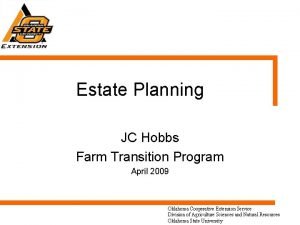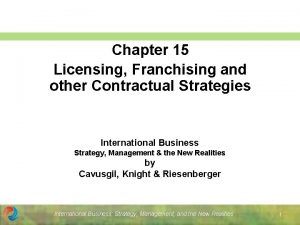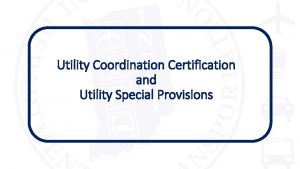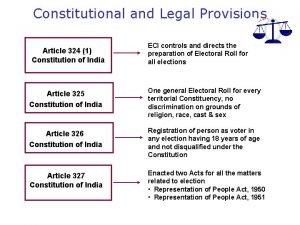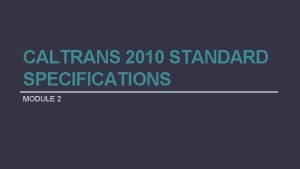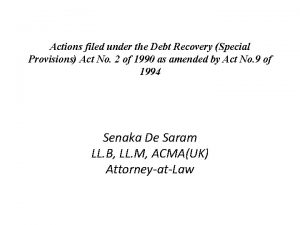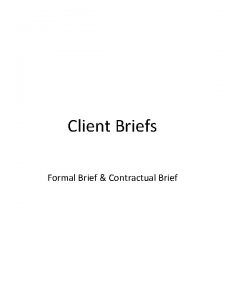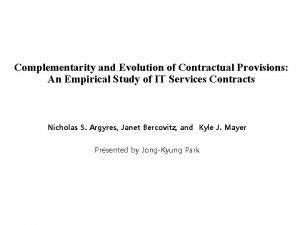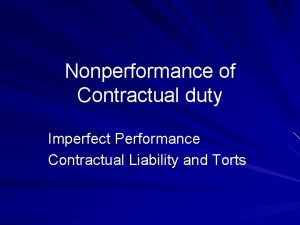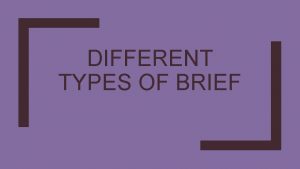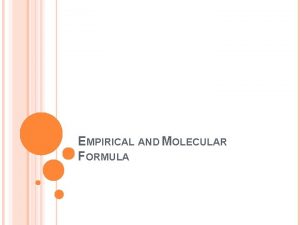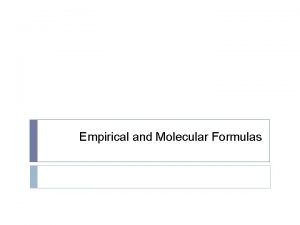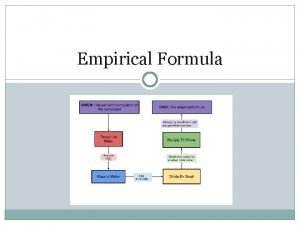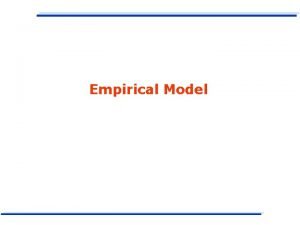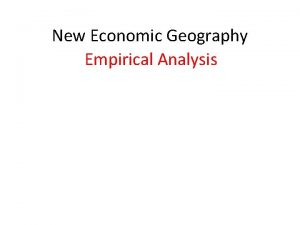Complementarity and Evolution of Contractual Provisions An Empirical















- Slides: 15

Complementarity and Evolution of Contractual Provisions: An Empirical Study of IT Services Contracts Nicholas S. Argyres, Janet Bercovitz, and Kyle J. Mayer Presented by Jong-Kyung Park

The need for research • The structure of the agreement plays a large role in determining the performance of the relationship. • However, systematic theoretical and empirical research is limited concerning how contracts are actually designed and how their structure evolve. Possible reason : the heavy emphasis in the management literature on the role of trust in inter-organizational relationship • Empirical research fails to investigate the evolutionary patterns in contract structure and mechanisms of learning to contract.

Research Purpose • To get a better understanding of the natural of contractual learning process by investigating the relationship among different elements of contract designs and their coevolution over time • Choose two categories of contractual provisions task description and contingency planning The reason: these are particularly important for contractual relationship in which environmental uncertainty, task or technological complexity are present Task description: • Including more detailed specification of the task to be completed. Contingency planning: • Defined as the parts of a contract that are designed to support within-agreement adjustments by proscribing the ways in which the contractual partners will deal with problematic contingencies that might arise during the execution of the contract.

Transaction cost economics • TCE theory of contract design is on idea about the functions of contracts that were first emphasized in legal literature • Business contracts are designed for the purpose of facilitating a transaction between two parties. • The TCE theory of contracting assumes that parties to a contract have bounded rationality that prevent them from foreseeing all possible future contingencies that may arise. • Due to this incompleteness, TCE argues that Contract terms should reflect certain key characteristics of the transaction. Degree of bilateral dependency Degree to which property right to assets SAFEGUARD

Learning and complements • In agency theory - Task definition and contingency planning are substitutes • Organization theory - Task definition and contingency planning are complement • Empirical economic literature on contract has tended to focus on explaining individual contract terms. • One important idea emerging from recent research on organizational complementarities: Dynamic way of thinking about the discovery of complementarities between organizational activities over time • Cross-Provisional learning As they develop one category of contractual provisions for a given contract, the contracting parties may gain understanding about transaction features that are useful in the design of a different category of contractual provisions.

Partner-specific learning • Two parties work together, they gain valuable knowledge both about the features of their transactions, and about each other’s idiosyncrasies more generally. • Experience can lead to a greater understanding of the exchange partner’s capabilities and needs, and to the development of a common language to define process and to resolve key uncertainties. • Accumulated knowledge about contingencies may enable the parties to codify roles and responsibilities in more detail, as well as to identify and specify pertinent contingencies with more accuracy at a lower cost.

Hypotheses • H 1: Contingency planning and task descriptions have reciprocal positive effect on one another. Complementary • H 2 A: Prior experience with contingency planning is associated with more detailed task description in subsequent contracts between the same firms. • H 2 B: More detailed task description in prior contracts is positively associated with contingency planning in subsequent contracts between the same firms. Cross-provisional Learning • H 3 A (B): As an exchange relationship between two parties continues, the parties will be more likely to include contingency planning (more detailed task description) in their contracts with each other Partner-Specific Learning

Data • Firm: Compustar • Period: 1986 -1998 • Sample: 405 agreement, 25% • According to the first letters of the customers name Unbiased sample • Remove 8 contracts with missing data, and 11 with abandoned type Final sample : 386 contracts Dependent and explanatory Variable • Contingency planning • Task description • Relationship history

Control variable Name Description Expected effect Interdependence • Control for the potential for holdup in each project • Coded as one if customer personnel are listed as being responsible for some portion of the project deliverables and zero otherwise. Contingency: + Task : + • Identify whether the technology used in the project makes it difficult to verify the quality of the output • Coded as one if quality is difficult to determine and zero if it is readily apparent. Contingency: Task : ambiguous Measurement cost Mainframe Programming Previous Fixed Fee Dollar value Time • Measure the degree of uncertainty associated with project • Coded as one if Compustar would be working with the buyer’s mainframe computer and otherwise zero. no a priori Expectations • Coded as one if project requires programming and zero otherwise Contingency: no Task: - • Measures aspects of incentive structure of the contracts • Fixed fee takes the value of one if the contract was based on a fixed fee and zero otherwise. Previous fixed fee is the number of fixed-fee contracts that parties to a given contract have used in the past Contingency: no Task: + • Control for the total money value of the project • Enter as log value since it is highly screwed. • Account for time trends and measure the passage of time from 1986 to 1998. • Zero for 1986, one for 1987 etc. Innovation • Captures the degree to which the project required innovation • A seven point Likert-type scale. Proprietary • coded as one f one or more of Compustar’s proprietary technologies were required for a project, and zero otherwise. Contingency: +

Model Specifications Basic OLS model Basic Probit model

Method Task description • Likert-scale measure - consider task description as a continuous variable • An endogeneity Problem - Durbin-Wu-Hausman, Contingency planning An endogeneity Problem – Smith-Blundell test • Hypothesis 2 A, 2 B • Examined the lagged effect of contingency planning on task description • Examined the lagged effects of task description on contingency planning Hypothesis 3 A, 3 B • The coefficient on relationship history will be positive and significant in all regressions.

Results OLS Estimates, Models of task Description • Contracts containing contingency planning tend to include more detailed task description • Support is found for one side of the hypothesized relationship of complementarity between task description and contingency planning (H 1). • The existence of contingency planning clauses in the prior contract written with a given customer is associated with great task description in the subsequent contract. • Evidence of learning spillovers from contingency planning to task description for the same customer, and therefore support for. H 2 A • The relationship history variable carries a positive non-significant coefficient in Models 1 and 3, and a negative non-significant sign in Model 2, • No support for H 3 A

Results MLE Estimates, Models of contingency planning • More detailed task description is associated with contingency planning, after controlling for transaction characteristics that affect task description detail separately. (H 1) • The positive and significant coefficient estimated for prior task description suggests that learning spillovers are occurring. (H 2 B) • The coefficient on the relationship history variable is positive and significant in all regressions. • Partners that have worked together for a longer period are more likely to include contingency planning in their contracts with each other. (H 3 B)

Results Time • The effects of time are very consistent across the three models. • Task descriptions are getting less detailed over time in these data. • Positive and significant in model 4, 5, 6 regressions. • The inclusion of contingency planning provisions increased in frequency over time. Interdependence • Positive and significant in all models • Transactions involving greater partner interdependence require more involved safeguards, such as those that contingency planning and task description can provide. • A positive and significant effect on contingency planning in Models 4 and 6 expected from TCE. Mainframe • Consistent negative sign, and is significant in Models 4 and 5. • Perhaps contingency plans are somewhat more difficult to make before a mainframe system is examined closely.

Findings • Contingency Planning and task description tend to act as complements in contract design, this complementarity likely results from learning spillovers between these two categories of contractual provisions. • Unexpected finding - Task Description tended to become less detailed over time. One possible explanation for this finding is that over time Compustar’s reputation for honest dealing became stronger among buyers, leading buyers to be less demanding of detailed task description. Another possibility is that Compustar over time began to learn that some types of detail were unnecessary in the contract, and buyers agreed. • Studying the determinants of each term in a contract, or each category of terms, as if it were independent of other term categories, can miss much of the action in contract designs. Limitations • Lack measure of trust and a long enough sample period Unable to test whether trust effects dominate the learning effects over me • Lack data on performance of the project Unable to evaluate whether increases in one tended to lead to better performance when the level of the other is higher.
 Life insurance contractual provisions
Life insurance contractual provisions Life insurance contractual provisions
Life insurance contractual provisions Life insurance contractual provisions
Life insurance contractual provisions New hobbs farm and provisions
New hobbs farm and provisions Licensing franchising and other contractual strategies
Licensing franchising and other contractual strategies Indot unique special provisions
Indot unique special provisions Ruins provisions
Ruins provisions Legal provisions
Legal provisions Caltrans standard specifications 2010
Caltrans standard specifications 2010 Define decree nisi
Define decree nisi Fidelity trust services fees
Fidelity trust services fees Fema provisions
Fema provisions 2015 nehrp recommended seismic provisions
2015 nehrp recommended seismic provisions Eu budget for the future
Eu budget for the future Define ethics
Define ethics Formal brief
Formal brief



